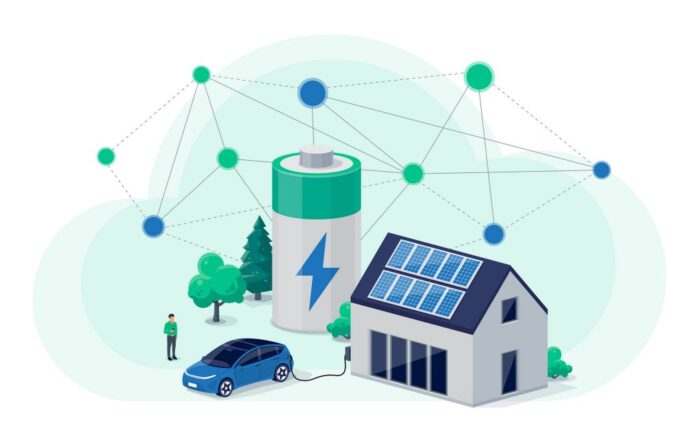Sunrun VPP output in 2024 rivals a fossil fuel power plant

Interest in virtual power plants (VPP) from utilities and homeowners is growing, so naturally Sunrun’s VPP network is growing right with it. With all the worrying about electricity prices and grid demands, the grid support from this fleet of distributed solar + storage assets is no joke, either. Sunrun reports that its VPP network has successfully supported a combined instantaneous peak of nearly 80 MW in power grids across the country in 2024 — a capacity greater than many traditional fossil-fuel power plants.
“Utilities are at a point where they can’t grow fast enough for the increased demand for electricity, which is why they are coming to Sunrun for help,” said Sunrun CEO Mary Powell. “Our power plant portfolio is at an inflection point because we have the resources and expertise to quickly develop, deploy, and scale programs to provide smart, controllable load. Combining solar with storage not only provides American families with energy independence and peace of mind, but also the ability to support the grid when it’s needed most.”
Sunrun’s storage-first approach has been key to its position in the VPP arena.
“With over half of new Sunrun customers installing storage, we are laying a strong foundation to create future programs where there is value for our customers, benefit to the grid, and revenue for Sunrun,” said Sunrun President and Chief Revenue Officer Paul Dickson.
In 2024, more than 20,000 Sunrun customers participated in 16 virtual power plant programs across nine states and territories. From California and Texas to Puerto Rico and New England, the customers’ batteries supplied on-demand, stored solar energy to augment power resources during hundreds of critical energy events.
Need for VPPs across the U.S.
Extreme weather events and soaring electricity demand underscore the importance for these power plant programs.
The North American Electric Reliability Corporation warns that over half the U.S. faces blackout risks in the next decade due to capacity shortfalls. Peak demand continues to climb with the rise of artificial intelligence, domestic manufacturing growth, and electrification of the economy. Data center load growth has tripled over the past decade and is expected to more than double by 2028.
Meanwhile, Sunrun’s 2024 virtual power plant output demonstrates the “power” of aa VPP network:
California: Over 16,000 Sunrun customers participating in California’s statewide CalReady program—the nation’s largest single-owner virtual power plant—delivering an average of 48 megawatts of stored solar energy to the grid during peak evening hours in the summer months. Output peaked at 54 megawatts, enough to power approximately 48,000 homes—equivalent to a city the size of Santa Monica.
Puerto Rico: Over 4,000 customers’ batteries participating in Sunrun’s PowerOn Puerto Rico program provided vital backup energy to the island’s grid during more than 70 energy shortfall events. Within just an hour’s notice, Sunrun dispatched its batteries as a single power plant to avoid rolling blackouts to help keep the lights on for communities across Puerto Rico.
Texas: Sunrun partnered with Tesla Electric, a retail electricity provider operated by Tesla Energy Ventures LLC, a subsidiary of Tesla, Inc., and Vistra on two virtual power plants in the Lone Star State. Customers receive an annual payment, currently set at $400 per Powerwall, while Sunrun earns recurring revenue through the program. The Vistra partnership also offers customers financial incentives and credits.
New York: Sunrun activated the state’s largest residential virtual power plant in collaboration with Orange & Rockland Utilities, Inc., a subsidiary of Consolidated Edison, Inc. Over 300 solar + storage systems provided stored solar energy during peak demand events in the summer. Participating customers received a free or heavily discounted home battery in exchange for their commitment to the 10-year program, while Sunrun received upfront payments from O&R.
Maryland: Sunrun launched the nation’s first bidirectional electric vehicle-to-home virtual power plant, partnering with Baltimore Gas and Electric Company (BGE), a subsidiary of Exelon Corporation, to utilize a small group of customer-owned Ford F-150 Lightnings. BGE was awarded grant funding from the Department of Energy to create the program, and Sunrun developed and operated this first-in-the-nation electric vehicle VPP. Participating customers earned several hundred dollars by sharing energy from their F-150 Lightning trucks.
“Sunrun is the industry leader, and we’re proving that every utility can and should have a virtual power plant program,” said Chris Rauscher, head of Grid Services at Sunrun. “Our largest and most successful programs are in Puerto Rico and California—places with vastly different power grids—but both equally benefiting from Sunrun customers’ solar-plus-storage systems being networked together to augment supply. I want to thank our amazing team which has turned the dream of VPPs into a reality.”





Comments are closed here.